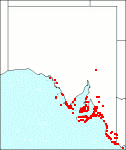|
Poa poiformis
Citation:
Druce, Rep. Botl Soc. Exch. Club Br. Isl. 1916:640 (1917). Comm_name: Tussock grass, coast (or blue) tussock grass.
Synonymy: Arundo poaeformis Labill., Nov. Holl. Pl. Sp. 27 (1804); P. australis sensu J. Black, Fl. S. Aust. 123 (1943), partly, non R. Br.; P. laevis R. Br., Prod. Fl. Nov. Holl. 179 (1810); P. australis R. Br. var. billardieri Hook. f., Fl. Tasm. 2:123 (1858); also spelt P. poacformis.
Common name: None
Description:
Densely tufted perennial, erect, 20-90 cm high, rarely with rhizomes; leaf blades more or less rigid, somewhat thick, usually strongly convolute and terete or angular-terete, the lower surface smooth, the inner scabrous.
Panicle 8-30 cm long, commonly contracted, if with spreading branches then at least some of the branches short and with spikelets almost to their bases; spikelets pale-greenish to straw-coloured, usually 3-5-flowered; glumes distinctly 3-nerved, 3-5 mm long; lemmas usually 4-5 mm long, usually scabrous on the keel above and hairy on the keel, lateral nerves and the margins below; web usually long and copious.
Published illustration:
Vickery (1970) Contr. N.S.W. natn. Herb. 4:pl. 15.
|
|
Distribution:
|
W.Aust.; N.S.W.; Vic.; Tas.; Lord Howe Island.
|
Conservation status:
native
Flowering time: Sept. — Jan.
|

SA Distribution Map based
on current data relating to
specimens held in the
State Herbarium of South Australia
|
Biology:
Typically a coastal species (see note following P. labillardieri) with rare records for inland localities.
Author:
Not yet available
|

